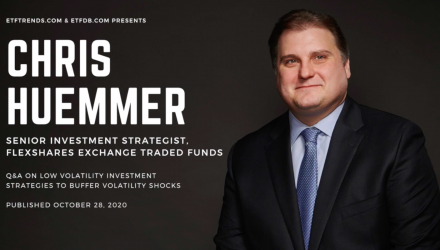While the U.S. equity markets are positive for the year, many investors are concerned with volatility events such as the U.S. election, the surge in Covid-19 cases, and other factors that can dramatically impact the markets. ETF Trends spoke with Chris Huemmer, Senior Investment Strategist at FlexShares Exchange Traded Funds, about using low volatility investment strategies as ways to buffer against volatility shocks.
To adjust portfolios, Huemmer notes how investors would typically de-risk by reallocating to fixed income. However, in this current environment, it may not be the most attractive approach. Yields are low, and future fixed income returns are likely to be muted in the short term. Additionally, with the quantitative easing and global fiscal stimulus, equity markets have continued to increase, leading to opportunity cost.
Instead, advisors have looked towards turning to volatility solutions offering downside protection while still participating in the upside potential of equity markets.
As Huemmer notes, “Thought we definitely have a lot of these events in the short term, and obviously, we’ve seen a lot of volatility here, in 2020, this is a trend that we’ve seen coming and playing out over the last several years.”
An Increase In Spikes
By that, he’s referring to before the global financial crisis, when there was less than one volatility spike per year, only to see a six-fold increase following the crisis. They are much more frequent on down days compared to up days. It’s been a steady pattern over the past decade.
With that in mind, FlexShares has paired a low volatility approach with its quality factor. Huemmer explains why in a couple of ways. One is contending with the poorest companies that happen to be the most volatile. Eliminating the poorest 20 companies based on quality means looking at their financial health and other factors, which allows for taking away a lot of what’s been seen historically with volatile companies.
The other way comes down to low volatility strategies. When the market outperforms and shows outside up market days, because of the defensive nature, low volatility tends to underperform. By pairing it with quality, it provides a much better upside capture.
For more market trends, visit ETF Trends.

